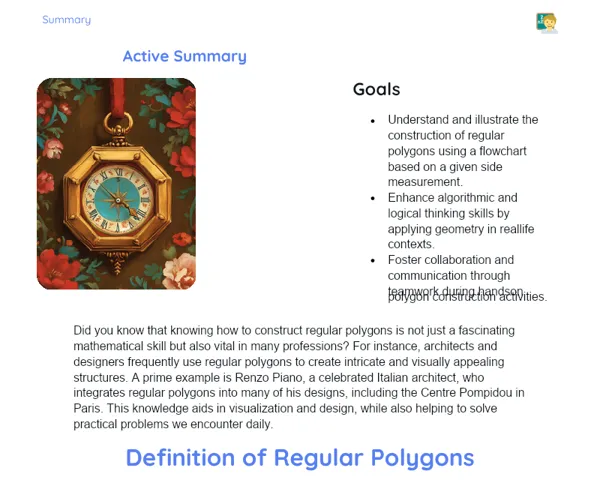Goals
1. Understand what a rectangle is.
2. Calculate the measures of sides and angles in a rectangle.
3. Solve practical problems involving rectangles.
Contextualization
Rectangles are all around us, often in ways we don’t consciously notice. From the smartphone we use to browse through social media to the dining table where we have our meals, rectangles are geometric shapes that significantly impact our daily lives. Grasping the properties of rectangles and knowing how to compute their measurements is not only essential for solving maths problems, but also crucial for fields like architecture, interior design, and civil engineering. For instance, an architect must accurately determine the areas and perimeters of rectangular spaces to design buildings that are both efficient and functional.
Subject Relevance
To Remember!
Definition of Rectangle
A rectangle is a four-sided figure (quadrilateral) with all angles measuring 90 degrees, known as right angles. Additionally, the opposite sides of a rectangle are equal in length and are parallel to one another. Thus, a rectangle has two dimensions: length and width, which are perpendicular to each other.
-
All angles are 90 degrees.
-
Opposite sides are equal and parallel.
-
It has two dimensions: length and width.
Properties of Rectangles
Rectangles possess unique properties, such as opposite sides being equal, having right angles, and the ability to be split into two congruent triangles by drawing a diagonal. These properties are crucial for many practical applications, including calculating areas and perimeters effectively.
-
Opposite sides are equal.
-
All angles are right (90 degrees).
-
Can be divided into two congruent triangles.
Calculating Perimeter and Area of a Rectangle
To find the perimeter of a rectangle, you add the lengths of all its sides, which is twice the sum of the length and width. The area is determined by multiplying the length by the width. Mastering these formulas is vital for addressing real-world problems involving rectangles.
-
Perimeter = 2 * (length + width).
-
Area = length * width.
-
These formulas are widely applicable in various practical situations.
Practical Applications
-
In architecture, accurately calculating areas and perimeters is crucial for designing functional internal and external spaces in buildings.
-
In graphic design, rectangles help create balanced page layouts, posters, and user interfaces, ensuring a visually appealing organization.
-
In civil engineering, knowledge of rectangle properties aids in determining surface areas and volumes, enhancing precision and efficiency in construction projects.
Key Terms
-
Rectangle: A four-sided shape (quadrilateral) with four right angles.
-
Perimeter: The total length of all sides of a geometric figure.
-
Area: The measure of the internal surface of a geometric figure, calculated by multiplying the length by the width in the case of a rectangle.
Questions for Reflections
-
How can the knowledge of rectangle properties benefit you in your future career?
-
In what ways can understanding area and perimeter help solve real-life problems?
-
What challenges have you encountered in constructing and calculating the properties of a rectangle, and how did you resolve them?
Drawing a Rectangular Space
To reinforce your understanding of rectangles, you will be tasked with drawing a rectangular space on graph paper, calculating its dimensions, and applying the concepts learned.
Instructions
-
Grab a piece of graph paper and a ruler.
-
Draw a rectangle that is 6 cm wide and 10 cm long.
-
Calculate the perimeter of the rectangle.
-
Calculate the area of the rectangle.
-
Document your calculations next to the rectangle on the graph paper.
-
Share your results with your classmates and discuss any variations or practical applications.



